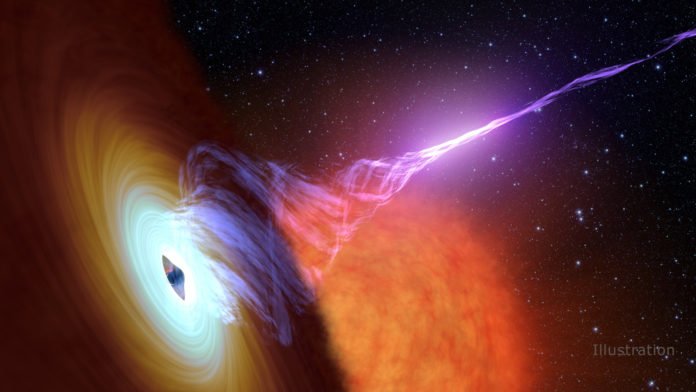Black hole, a region in space where gravity is immense that light is able to escape. They are especially known by ravenous eaters, but they do not swallow anything until the object falls toward them.
A little bit of material gets shot to pull out of planes of hot gas, called plasma, that can wreak destruction on their environment. This plasma by one means or another gets sufficiently energized along the black hole’s axis of rotation.
Scientists have long debated where and how this happens in the jet. Now, scientists have discovered a clue to this mystery. They have measured the distance that particles in jets travel before they “turn on” and become bright sources of light. Scientists called this distance as acceleration zone.
For this task, they used Milky Way called X-ray binaries. Each of them involves a black hole that feeds a normal star.
Studying them separately during periods of an outburst, scientists found that a flat structure of material orbiting the black hole — brightens because of material falling in.
One system, called V404 Cygni, had reached nearly peak brightness when scientists observed it in June 2015. At that time, it experienced the brightest outburst from an X-ray binary seen in the 21st century. The other, called GX 339-4, was less than 1 percent of its maximum expected brightness when it was observed. The star and black hole of GX 339-4 are much closer together than in the V404 Cygni system.
But both systems showed similar time delays of one-tenth of a second when NuSTAR first detected X-ray light and ULTRACAM detected flares in the visible light slightly later. That delay is less than the blink of an eye but significant for the physics of black hole jets.
Poshak Gandhi, lead author of the study said, “One possibility is that the physics of the jet is not determined by the size of the disc, but instead of the speed, temperature and other properties of particles at the jet’s base.”
X-ray light emitted by material very close to the black hole explain the results. Strong magnetic fields propel some of this material to high speeds along the jet. It causes particles to collide near light-speed and thus charge plasma to emit the stream of optical radiation.
Integrating amount of time traveled by particles, similar to the speed of light, scientists found that maximum distance traveled. This expanse of about 19,000 miles (30,000 kilometers) represents the inner acceleration zone in the jet, where plasma feels the strongest acceleration and “turns on” by emitting light. That’s just under three times the diameter of Earth, but tiny in cosmic terms, especially considering the black hole in V404 Cygni weighs as much as 3 million Earth put together.
Daniel Stern, the study co-author said, “Astronomers hope to refine models for jet powering mechanisms using the results of this study.”
Gandhi said, “We are excited because it looks as though we have found a characteristic yardstick related to the inner workings of jets, not only in stellar-mass black holes like V404 Cygni but also in monster supermassive ones.”
“The next steps are to confirm this measured delay in observations of other X-ray binaries, and to develop a theory that can tie together jets in black holes of all sizes.”
